Civil Rights / Cold War
Sun Records & Rock and Roll
Rock and roll exploded out of Memphis in the 1950s with the founding of Sun Records by Sam Phillips.
Rock and roll was a new style of music that mixed blues, hillbilly, and gospel. Elements of the music could be heard in many records during the 1940s and 1950s. A Cleveland, Ohio, disc jockey, Alan Freed, is credited with coming up with the name to describe the music.
But it was a Memphis singer named Elvis Presley whose recordings at Sun Records really put rock and roll at the forefront of popular music.
The largest record companies like Columbia, Capitol, Decca, and Victor concentrated on pop music. They ignored black artists and rhythm and blues (R&B). This opened the door for small independent record companies to step in and start recording these artists.
One of these small independents was Sun Records, established by Sam Phillips in 1950 as the Memphis Recording Studio. Ike Turner’s band (later of Ike and Tina Turner fame) recorded a song there in 1951 that many historians consider to be the first rock and roll record, “Rocket 88.” It was only a small hit for the studio.
In 1952 Phillips formed his own label named Sun Records. Sun's early artists included black artists like Rufus Thomas, B.B. King, and Howlin' Wolf.
As white teenagers became interested in rhythm and blues, the independent record companies began to cash in. As they did, the larger recording companies begin to show interest in the new music style.
Many record companies, still thinking that only whites could be commercially successful, hired singers like Tennessean Pat Boone to cover R&B songs. Boone recorded “Ain’t That a Shame” by Fats Domino and took it to number one on the pop charts. Boone’s version didn’t have the authentic blues feel of Domino’s, but it sold a lot more records.
Elvis
Popular lore has it that Phillips looked long and hard for “a white man who could sing like a Negro” to cross over into the mainstream market. In 1953, Phillips got that white man in Elvis Presley.
Elvis hung around the studio until Phillips gave him a chance to sing. Presley recorded his first record for Sun Records, “That’s All Right (Mama)”, a -cover- of an earlier song by African American artist Arthur “Big Boy” Crudup. The song became a hit.
Phillips realized that the playing of two Sun session musicians, Bill Black and Scotty Moore, played an important role in developing Elvis’ rock and roll sounds. He gave them part of the royalties from Elvis’s records. After Elvis moved on to another recording company, both men no longer received their royalties from Elvis' songs.
Phillips sold Elvis’s contract to RCA Records for $35,000 in 1955. This enabled him to get out of debt and concentrate on new singers.
Johnny Cash lived in Memphis and started stopping by Sun Records to try and meet Sam Phillips. Phillips was never available until Cash ran into him outside the office. Phillips agreed to hear Cash, and ended up recording him.
Sun released Cash’s first record in 1955. Cash, unlike Elvis, wrote his own songs. Two of them, “Folsom City Blues” and “I Walk the Line,” became huge hits for Sun and Cash. Cash too left Phillips and signed with Columbia Records.
Some music critics said that Cash’s songs after Sun Records never sounded quite as good. It was as though it took Phillips’ mixing board to produce Cash’s music, perhaps “the most original and innovative sound in country music since Hank Williams died.”
Carl Perkins
Sun’s biggest hit was Carl Perkins’ “Blue Suede Shoes,” released in 1955. Perkins said his music was a mixture of blues and honky-tonk. “I just speeded up some of the slow blues licks,” he said.
“That’s what ...rock and roll was to begin with: a country man’s song with a black man’s rhythm.”- Carl Perkins
Perkins’ “Blue Suede Shoes” was the first country music record to reach the R&B charts. But like the singers before him, Perkins also left Sun Records and was signed by Columbia in 1958. The big record companies could offer the singers more exposure and promotions and therefore more money than the smaller independents could. Listen to part of "Blue Suede Shoes"
http://tn4me.org/audio/Blue_Suede_Shoes_edited.mp3
While Perkins did not become as big of a star as Cash and Presley, his music was a great influence on rock and roll singers in the 1960s. The Beatles recorded five of his songs, which meant he earned royalties from their huge sales of records.
Singers Roy Orbison and Jerry Lee Lewis also got their start at Sun Records in the 1950s and then left for major record companies. Lewis scored hits at Sun with “Whole Lotta Shakin’ Going On” and “Great Balls of Fire.”
As the major record companies started signing black and white R&B and rock singers, the independents began to suffer. Phillips cut his final record in 1968 and sold his catalog of recordings in 1969.
Phillips, who was not a musician, was successful for a time because he had an ability to find talented performers with unique styles, and he developed ways to record them that captured that style and talent.
Perkins said Phillips was “as near a genius as any man I ever met.” Phillips would tell the singers to, “'Get in there and pick boys. We’ll find a record when we get through,'” Perkins said.
The Sun Records experience was brief, but important. It helped Memphis gain prominence as a music center in the eyes of the world.
Picture Credits:
- Photograph of Memphis’s Sun Studio in 2007. Sun’s original studio was located in the section to the right, underneath the neon sign reading “SUN.” The larger section was a soda fountain during the 1950s. Photo by G. Graham Perry III, Tennessee State Museum
- Photograph of the front cover of November 1969 Life magazine featuring Johnny Cash, "The Rough-cut King of Country Music." The article said: "His face looks ruined, the lean body whipped out. He sings of bygone days that many of his listeners can't even remember....As the undisputed king of country music, he has won a nationwide following for the type of singing that city folks used to scorn." Tennessee State Museum Collection
- In 1956 both Elvis Presley and Johnny Cash dropped by Sun Records in Memphis to visit. Carl Perkins and Jerry Lee Lewis were there doing recording sessions. Sam Phillips, owner of Sun, persuaded them to sit down and sing together. He also turned his tape recorder on. The group sang mostly gospel music, but a photograph was taken and later ran under the headline of "Million Dollar Quartet" as all four men either had or would later sell millions of records. This is the cover of an album of the recordings produced in 1981. Tennessee State Museum Collection
- A photograph, undated, of Sam Phillips sitting at his recording board at Sun Records in Memphis. Tennessee State Museum Collection
- Photograph of Carl Perkins signing autographs in 1956 after he performed at the Overton Park Band Shell in Memphis. The newspaper reported that some 5,000 teenagers had turned out that night for a two hour show featuring Perkins and other rock and roll performers. Elvis Presley even made a surprise appearance. Courtesy of the photographer Robert Williams and The Commercial Appeal.
- Photograph of a young Elvis with a duck tail hair style. Part of "Elvis: A 1990 Calendar." Tennessee State Museum Collection
Acknowledgments:
- Blue Suede Shoes, By: Carl Lee Perkins. Used by Permission of Wren Music Co. o/b/o Carl Perkins Music, Inc. (BMI). Audio Recording used by Permission of Sun Records
Civil Rights / Cold War >> Everyday Life >> Music >> Sun Records & Rock and Roll
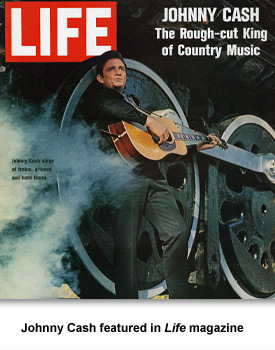
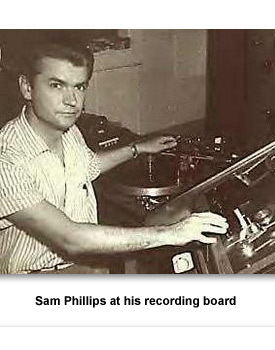
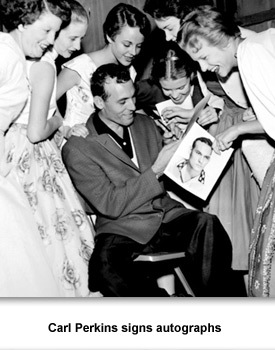
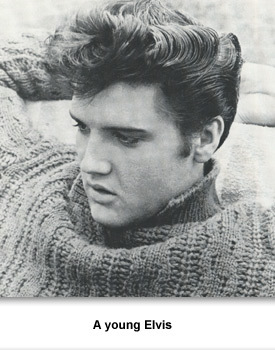
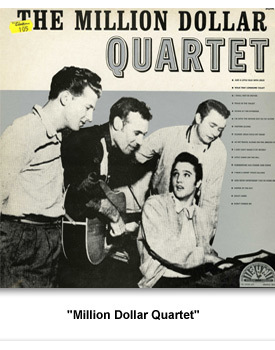
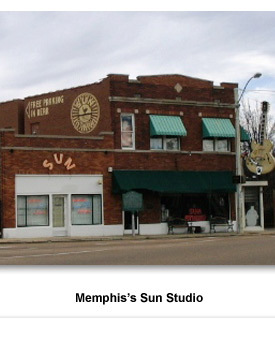
 Sponsored by: National Endowment for the Humanities
Sponsored by: National Endowment for the Humanities